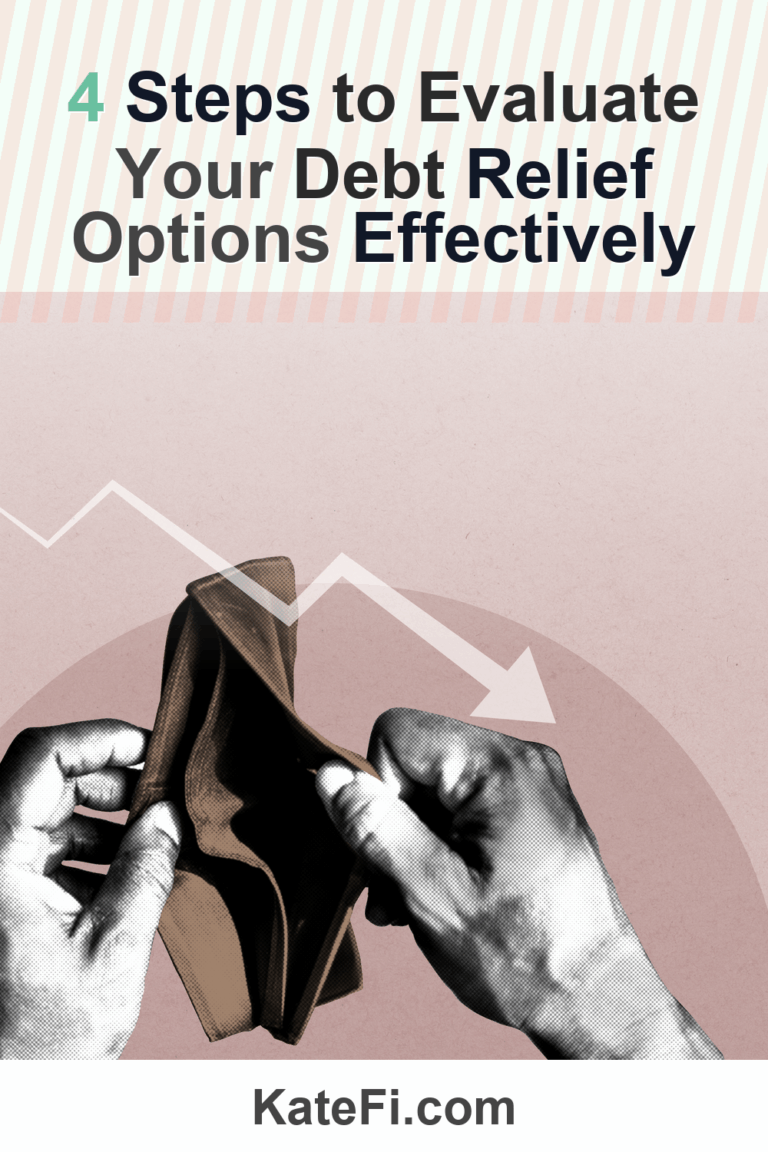4 Steps to Evaluate Your Debt Relief Options Effectively
Facing debt can feel overwhelming, and navigating your relief options may seem like an insurmountable challenge. But with a strategic approach, you can take control of your financial situation. This guide will provide you with practical steps to evaluate your debt relief options effectively, ensuring that you can make informed decisions to slow the snowballing interest and fees that come with unpaid debts.
Love our content? Show your support by following us — pretty please!🥺
FOLLOW ON PINTEREST
Hi! I’m Kate, the face behind KateFi.com—a blog all about making life easier and more affordable.
By following these four steps, you’ll be better equipped to assess your circumstances and choose the best path forward, all while highlighting the importance of consulting with professionals like those at KateFi for a free consultation to review your options.
Step 1: Assess Your Current Financial Situation
What You’ll Learn on the Call
- Estimated timeline and monthly payment range
- How credit may be affected in the short term
- What documents to gather to move faster
Not available in IL, KS, OR, TN, UT, WV.
Before diving into the options available for debt relief, you first need to take a detailed look at your financial landscape. Understanding where you stand will help you weigh the right alternatives for your circumstances.
Checklist to Evaluate Your Financial Situation:
- Total amount of debt: List all your debts, including credit cards, personal loans, student loans, and medical bills.
- Interest rates: Note the interest rates for each debt, as high-interest debts can snowball quickly if left unchecked.
- Monthly payments: Calculate your monthly obligations and how they align with your income.
- Discretionary spending: Assess your budget to identify areas where you can cut back to allocate more towards debt repayment.
Gathering the following documents will also expedite your review process:
- Recent pay stubs
- Bank statements
- Credit card statements
- Loan agreements
- Any relevant correspondence from creditors
By having a complete picture of your finances, you’re setting yourself up for a successful evaluation of debt relief options.
✅ See If You Qualify for Debt Relief
Step 2: Understand the Different Types of Debt Relief Options
Once you have a clear understanding of your financial status, the next step is to familiarize yourself with the various debt relief options available. Not all strategies will be suitable for every situation, and understanding the differences can significantly impact your decision-making process.
Common Debt Relief Options:
- Debt Settlement: Involves negotiating with creditors to pay less than what you owe. While it can lead to significant savings, it may impact your credit score.
- Debt Consolidation: This option combines multiple debts into one single loan with a lower interest rate. It can simplify payments but requires discipline in managing new debt.
- Credit Counseling: Professional services that help you manage your debts through budgeting advice and, sometimes, setting up a debt management plan.
- Bankruptcy: A legal process that can eliminate most debts but will have severe impacts on your credit score. This should generally be considered as a last resort.
Comparison Table of Debt Relief Options
| Option | Pros | Cons | Credit Impact |
|---|---|---|---|
| Debt Settlement | Potential savings | May harm credit score | Negative impact |
| Debt Consolidation | Simplified payments, lower interest | Requires discipline | Varies, potentially negative |
| Credit Counseling | Professional guidance | Fees may apply | Minimal if on a management plan |
| Bankruptcy | Fresh start | Long-term credit impact | Significant negative impact |
As you explore these options, it’s critical to consider not only the potential benefits but also the risks and long-term implications on your financial health.
✅ See If You Qualify for Debt Relief
Step 3: Weigh the Pros and Cons
Understand pros/cons of settlement vs consolidation vs DMP for your exact mix of debts.
Not available in IL, KS, OR, TN, UT, WV.
After narrowing down your options, it’s time to weigh the pros and cons of each strategy. Consider your unique situation, including your credit standing, the amount of debt you owe, and your financial goals.
Script for Evaluating Options:
- What are the total costs associated with this option?
- How long will it take to see results?
- How will this choice affect my credit score?
- What are the chances of successfully achieving my debt relief goals?
While each option has its merits, consider potential pitfalls:
- Debt Settlement: While it might save you money, some creditors may refuse to negotiate or accept reduced payments, leading to further collection actions.
- Debt Consolidation: If you’re not careful, you might end up accumulating more debt while trying to pay off existing ones.
- Credit Counseling: Ensure you choose a reputable agency to avoid scams or high fees.
- Bankruptcy: The long-term consequences may outweigh the immediate relief.
This thoughtful consideration will help you make the best choice for your long-term financial health.
Step 4: Seek Professional Guidance
Navigating the maze of debt relief options can be daunting. Consulting with professionals, such as the experts at KateFi, can provide you with tailored advice and insight into your unique situation.
Having a fresh perspective can reveal options you might not have considered and help you make informed decisions. In your consultation, you’ll have the chance to:
- Review your financial situation in detail.
- Explore all available debt relief options specific to your needs.
- Get answers to your pressing questions about credit impact, fees, and timelines.
Taking this step can be transformative, and you may find a path forward that not only alleviates your current debt but also helps you develop a sustainable financial future.
✅ See If You Qualify for Debt Relief
The Bottom Line
👉 Start Your Free Debt Relief Review
Not available in IL, KS, OR, TN, UT, WV.
Dealing with debt is no easy feat, but with a strategic evaluation of your options, you can find a way to manage or eliminate it. Understanding your current financial situation, knowing your relief options, weighing the pros and cons, and seeking professional guidance are the four crucial steps you can take toward financial freedom.
Remember, interest and fees can snowball quickly, leading to an even more daunting financial burden. By acting proactively and reaching out for help, you can slow down that snowball and take meaningful steps toward relieving your debt.
Important: This content is for education only—not legal, tax, or financial advice. Results and eligible programs vary by situation and state. Fees apply if you enroll and complete a program. Debt relief can affect credit; missed payments may lead to collections/lawsuits. Not available in IL, KS, OR, TN, UT, WV.
Now that you have the knowledge and tools to navigate your debt relief options, don’t hesitate to reach out to professionals who can assist you on your journey. Taking the first step is often the hardest, but it’s also the most crucial. Start today!






















